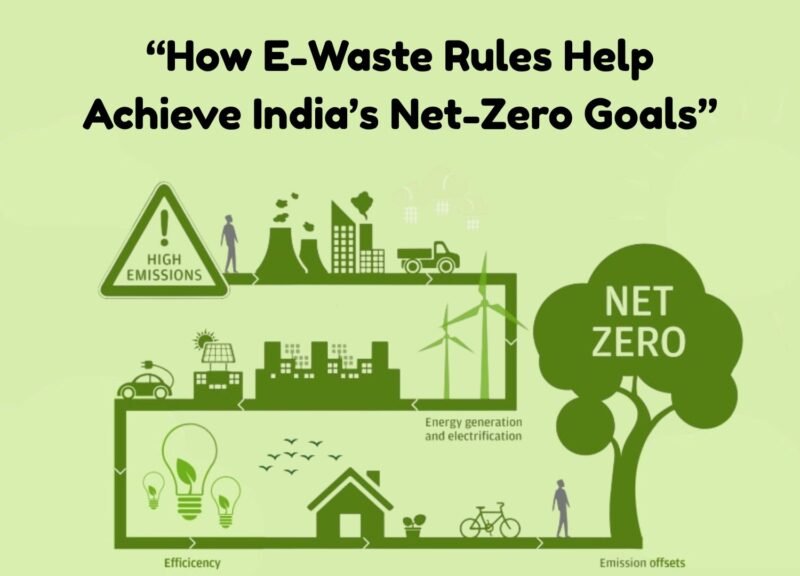How E-Waste Rules Help Achieve India’s Net-Zero Goals
India’s ambition to achieve net-zero emissions by 2070 is one of the most ambitious global climate commitments. But achieving it goes beyond renewable energy adoption — it demands responsible resource recovery and waste management. Among all waste categories, electronic waste (e-waste) is the fastest-growing and one of the most carbon-intensive in its lifecycle.

The E-Waste (Management) Rules, 2022 link India’s recycling revolution directly to its net-zero agenda, introducing reforms that reduce emissions, conserve critical materials, and formalize recycling.
The Carbon Link: Why E-Waste Matters for Net Zero
Every smartphone, laptop, and circuit board contains metals like copper, aluminum, and gold — all extracted through energy-intensive mining. When these are discarded rather than recycled, we lose embedded carbon savings and reintroduce emissions from fresh extraction.
- Recycling aluminum uses 95% less energy than mining it.
- Recycling copper saves about 85% of energy.
- Recycling one tonne of e-waste prevents around 1.4 tonnes of CO₂ emissions.
Thus, efficient e-waste recycling doesn’t just manage pollution — it directly offsets emissions and contributes to India’s climate targets.
The 2022 Rules: How E-Waste Rules Help Achieve India’s Net-Zero Goals
The updated E-Waste (Management) Rules, 2022 replace the outdated 2016 framework and focus on transparency, accountability, and emission reduction.
Key Climate-Relevant Provisions:
- Extended Producer Responsibility (EPR): Producers must ensure a specified percentage of e-waste is recycled. This converts corporate compliance into a measurable climate contribution.
- Digital Portal Integration: CPCB’s e-waste portal allows real-time monitoring and carbon accounting, reducing leakages and fake recycling claims.
- Inclusion of Solar Waste: Solar PV panels and cells — vital to clean energy — are now regulated, ensuring renewable waste doesn’t harm the environment.
- Environmental Compensation (EC): Financial penalties for non-compliance deter illegal dumping and emissions from burning or informal processing.
- Formalization of Informal Sector: Rules encourage integration of informal recyclers through partnerships and licensing.
Circular Economy & Resource Efficiency
E-waste rules directly support India’s circular economy and Mission LiFE (Lifestyle for Environment) vision by:
- Keeping materials like rare-earth metals in circulation.
- Reducing dependence on imported virgin raw materials.
- Encouraging refurbishing and reuse to extend product lifecycles.
Circularity ensures fewer new products are manufactured, which reduces energy use, emissions, and material waste — crucial pillars of the net-zero roadmap.
Net-Zero Infrastructure: Delhi’s E-Waste Eco Park
India’s first net-zero e-waste eco park in Delhi exemplifies sustainable waste management. Built on a ₹150-crore budget, it will:
- Process over 50,000 tonnes of e-waste annually.
- Operate entirely on renewable energy.
- Use AI-driven sorting and real-time carbon tracking.
- Train informal sector workers for safe, green jobs.
This model can be replicated nationwide, aligning waste management infrastructure with India’s Nationally Determined Contributions (NDCs) under the Paris Agreement.
Economic and Social Impact
The e-waste sector can generate half a million green jobs by 2035 while supporting India’s clean-tech industries. Companies like Attero Recycling, TES-AMM, and Cerebra are already extracting critical minerals — lithium, nickel, cobalt — that feed India’s EV and battery manufacturing ecosystem. This strengthens India’s rare-earth independence and reduces emissions from mining abroad.
Quantifying the Climate Gains
| Climate Impact | Estimated Benefit |
|---|---|
| CO₂ Avoided per tonne recycled | 1.4 tonnes |
| Annual reduction if 70% e-waste recycled | ~4–5% of industrial emissions |
| Carbon finance potential | $2–3 billion through verified carbon credits |
Formal recycling at scale can thus provide measurable progress toward India’s net-zero emissions by 2070.
Global Lessons for India
- Japan: 80% metal recovery under its Home Appliance Recycling Act.
- Germany: Circular economy policy ties recycling to carbon credits.
- South Korea: National e-waste plants powered entirely by renewables.
India can adopt these frameworks by linking EPR Certificates with carbon markets — rewarding verified emission reductions.
Road Ahead: Bridging Policy and Practice
To fully align e-waste rules with climate action, India must:
- Expand formal recycling infrastructure across all states.
- Offer carbon-linked incentives for verified recyclers.
- Mandate emission reporting for EPR compliance.
- Integrate informal recyclers via capacity-building programs.
- Raise awareness under Mission LiFE about the carbon impact of e-waste.
The Big Picture: Waste as a Climate Asset
How E-Waste Rules Help Achieve India’s Net-Zero Goals strategy represents a paradigm shift — turning discarded electronics into a climate mitigation tool. With every recycled device, India not only curbs pollution but also reduces emissions, saves energy, and preserves critical materials.
By uniting climate policy and waste management, India positions itself as a global leader in sustainable circular innovation — proving that even the smallest circuit can power a cleaner, carbon-free tomorrow.
FOR MORE BLOGS – beyondthepunchlines.com

 Add to favorites
Add to favorites








